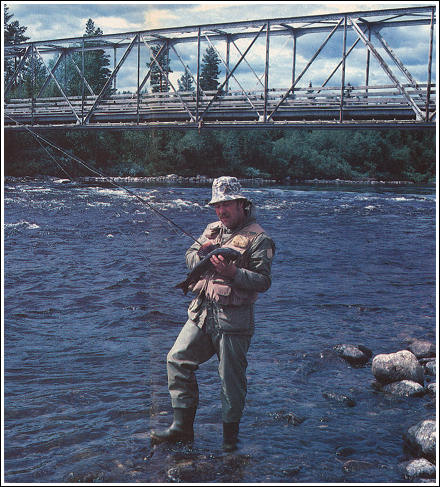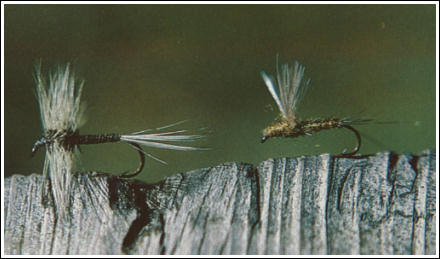|
Grayling, the
perfect fish for fly fishing
By Sune Adolfsson
On
the third cast the big grayling rose and took the dry fly. Then
the fish took off down stream in full speed. I had seen the
cautious wake rings on the blank area at the stream head - and
like so many times in the past underestimated them in the belief
that they were from smaller graylings.

First
run pulled out all the fly line - and I was just as surprised as
the fish on the other end. After a walk of about 50 meters
downstream, I managed to pull the grayling to the river bank -
and a few minutes later slipped into the net. A splendid
grayling maybe just over a kilo. It was a delight for me to look
at, where it lay among the beach rocks and sparkled in the
sunshine. Large grayling was successfully landed.
This small fishing
episode can be seen as fairly typical when one makes contact
with large grayling. One of the many charms of the grayling
fishing is the difficulty in determining the size of the fish by
looking at the wake ring. Gently and barely noticeable the rings
spreading out like an autumn leaf falling on the water surface.
If you are grayling fishing you should not underestimate any
wake.
Ideal fish for
flyfishing
The grayling were once
as an inferior alternative to the more honorable trout. Largely
because they saw the trout as more of a strong fighter, also
somewhat more difficult to cheat compared to grayling.
But the trend has in
recent years turned, and today it's probably not many people
that underestimate grayling fishing. Sure, smaller grayling
become a little tiresome in the long run - but the same can be
said for smaller trout.
A meeting with a 1 kg
grayling you will remember for ever. The saying that adult
grayling would be more “gullible” fish than adult trout should
probably be regarded as a myth. On the contrary, grayling can be
extremely picky and not take a fly that drags even the
slightest.
The major difference
between the two fish - except that the trout will be
considerably larger than the grayling - is that the grayling is
the ideal flyfishing fish. Trout will early change to the fish
diet to manage its rapid growth. .Grayling contrast from that by
being on insect diet for life and is thus for fly fishermen the
perfect target
When can you call a
grayling for big grayling? This can obviously be a personal
judgment. I myself remember how it felt when I managed to hook
my first grayling around half a kilo. After the first moments of
heart throbbing had quiet down somewhat, I thought it was the
most impressive and largest grayling ever been viewed as on this
side of the globe.
Grayling maximum weight
is around 2.5 kg. A grayling on 8 hg and up will probably be
considered a big fish - that is, in my opinion, a big grayling.
The three R's
To get in contact with
big grayling it is important that the "three R's" rule is met.
The right water, the right time, and last but not least, the
right fly.
The Right waters
are still numerous in our latitudes and conditions for having
contact with large grayling, may even today be considered good.
The larger rivers, from Klarälven in the south to the far north
in Sweden, and several rivers in Norway, have good populations
of full grown grayling.
The Right time
may include the weeks around midsummer, when the mayflies are
active in most grayling water. With the exception of some rivers
in the northern latitudes where hatchings of mayflies can be
extremely sparse. Autumn is also a very fine time for grayling.
Caddis are very active and can sometimes offer a superb fishing.
September is the classic grayling months, and is seen by many
fly fishermen as by far the best grayling time.
The Right fly can
at times be quite tricky to figure out when you're on grayling
fishing. The grayling is a moody fish and can suddenly refuse to
take on the same fly that it minutes before was totally obsessed
on. But most of the times you can get it to rise to a high
floating dry fly in the right size. The grayling is otherwise a
grateful fish and will gladly help them to the served dinner
table on the water surface. Which means dry flies tend to be
useful most of the season? Even smaller nymphs should be
included in the fly box - and presented just below the surface,
they can be extremely effective. More about the flies later.
The weather gods are
notoriously another factor that can cause problems when you are
on a fishing trip. Grayling is a sun liking fish. In rainy and
gray weather, it can sometimes be hard to get in touch with. A
heavy weighted nymph on a long thin leader can at these times be
the only solution.

Badger
Variant and No-hackle fly
Light rods - long
backing
To fish for grayling
with stiff, heavy rods are not successful. Light rods in classes
4-6 is better suited and also gives a much greater chance of
keeping fish.
When fishing at Kaitum
River for a number of years ago, I got myself to learn the
lesson that stiff rods and grayling fishing do not mix. I fished
with a rod #7-8 and 8.5 feet long. In other words, a real
"canon" is far from being a grayling rod. After a few valiant
attempts, I managed to hook a giant grayling on a small Black
Gnat No. 16. After a crazy run and about 15 minutes of play I
had the fish in reach for netting. Suddenly the fish started to
run again, and the fly got loose and went to the air in a wide
curve. The hook was completely straightened - and the adventure
was over. How much it weighed? Enough to make long lasting marks
in the few "fish nerves" I had left.
The error was that the
rod was too stiff relative to the hook size. The rod gave to
strong resistance when the fish started his sudden run again.
The grayling is also quite soft in the mouth and also this is an
argument for softer lighter rods.
Nowadays I use a carbon
fiber rod in #4-5, but makes up for it with a long backing of at
least 50-60 meters. This rod set the hooks excellent and makes a
soft resistance when the fish surprisingly makes a rush. Now I
get to keep my big graylings.

Two caddi
flies that grayling happily consumes
Streaking Caddis and Europea-12
High Floating flies
In the case of dry flies
position on water surface - and it will apply to both hackled
and non hackled, I have been able to establish that they should
stand high on the water. In other words, the fly should be on
its toes!
Quality if hackle should
be of the highest class and fly then dipped in a floating
liquid. As an extra impregnation, I also just prior to the
fishing further treat it sparingly with some leader grease on
the hackle and tail fibres. I can warmly recommend natural
product Ragot (also called wild boar fat) which is excellent for
this purpose. But avoid getting it on the fly line - Ragot
contain substances which could have a deleterious effect on
today's synthetic lines! It may seem a little excessive to also
grease the fly, but the result is excellent. You get a very high
floating fly, and it floats for long. Although it becomes wet
from the fish, it becomes dry and high floating again after a
few air throws.
Combining good hackle,
good impregnation can sometimes be the only medicine to come
into contact with watchful big grayling.

Black Nymph and Hare Ear Nymph still works good for catching
grayling
Short reach
Long casts are rarely
necessary when on grayling fishing.
Around midsummer last
summer, I stood and cast with my fly rod along with some other
fly fishers, at one of the bigger rivers in mid Norway. The fish
was feeding from surface; the menu consisted of abundant
hatchings of mayflies and caddis. Thus an ideal relationship for
fly fishing.
Most fishermen focused
entirely on getting as far out as possible. They used so much
force as it made creaking noises in their arms - and the result
was only a big number of lost flies in behind located river
embankment.
I had observed a number
of wakes only a few meters from the shore. Rather than join with
the long distance casters, I decided to try some casts on these
close by grayling. It was not long before the first take. My
caddi imitation sat firmly in the mouth of a grayling and there
were no major difficulties to maneuvering the caught grayling to
the shore. A fine grayling just over a kilo – caught just by
casting 6 meters!
By Sune
Adolfsson © 1984
Article
translated from Swedish by using Google Translate service
We apologize if the grammar is not perfect |